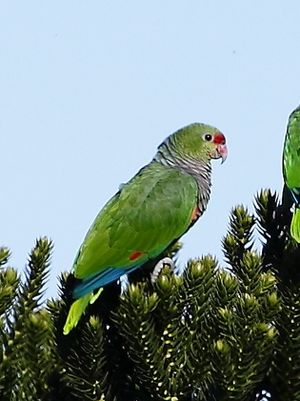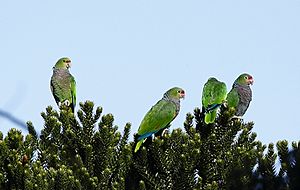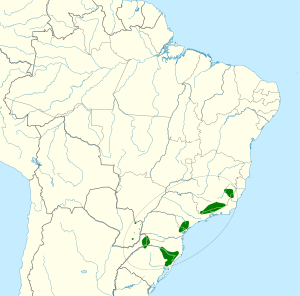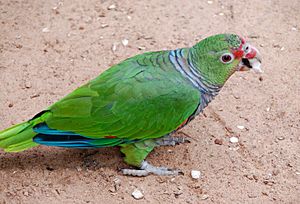Vinaceous-breasted amazon facts for kids
Quick facts for kids Vinaceous-breasted amazon |
|
|---|---|
 |
|
 |
|
| Conservation status | |
| Scientific classification | |
| Genus: |
Amazona
|
| Species: |
vinacea
|
 |
|
The Vinaceous-breasted Amazon (Amazona vinacea) is a colorful parrot found in South America. It is also called the Vinaceous-breasted Parrot. This bird is an endangered species, which means it is at risk of disappearing forever. You can find it in countries like Argentina, Brazil, and Paraguay.
Contents
What Does It Look Like?
The Vinaceous-breasted Amazon is about 30 to 36 centimeters (12 to 14 inches) long. Most of its body is green. It has bright red feathers on its face, near its beak and forehead. The back of its neck is a pretty turquoise color. Its chest has a lovely lilac (light purple) shade.
This parrot also has red on the edge of its wings and at the base of its outer tail feathers. The tips of its main wing feathers are blue to black. Its beak is pinkish-red at the bottom and horn-colored (a light brownish-yellow) at the tip. Its eyes are red-orange or chestnut brown, surrounded by pale gray skin. Its legs and feet are gray.
Where Does It Live?
The Vinaceous-breasted Amazon lives in different, scattered places. It is mainly found in southern Brazil, eastern Paraguay, and a small part of northeastern Argentina. It used to live in more areas, further north and south.
This parrot makes its home in the Atlantic Forest. It especially likes forests that have many paraná pine trees. You might also see it in smaller forest patches, young forests, or even in areas with scattered trees like pastures. Sometimes, they are found near towns or in plantations of other trees.
How Does It Behave?
Movement and Travel
These parrots do not all move in the same way. Some stay in one place all year. Others might only be in certain areas during their breeding season.
What Does It Eat?
The Vinaceous-breasted Amazon usually looks for food high up in tree-tops. They often feed in groups. In winter, they mostly eat the seeds of the paraná pine tree. But they also eat seeds, fruits, buds, and flowers from more than 30 different kinds of plants. Some of these plants are native, and some were brought in by people.
Life Cycle and Reproduction
The Vinaceous-breasted Amazon usually breeds between August and December. Sometimes, the breeding season can last until March. They build their nests inside holes in trees. These holes might be natural, caused by rot, or made by woodpeckers.
The female parrot does most of the incubation, which means sitting on the eggs to keep them warm. This lasts for about a month. A mother parrot usually lays two to four eggs. Both parents help feed the baby parrots. In captivity, the young birds are ready to leave the nest when they are about seven to ten weeks old.
Sounds and Calls
When the Vinaceous-breasted Amazon is in its nest or looking for food, it is usually quiet. But when it is flying or sitting away from the nest, it can be very noisy! Its typical call sounds like "creo creo" or "crau crau" to some people. Others describe it as "wout-wout-" or "wi-rout wi-rout".
Why Is It Endangered?
The Vinaceous-breasted Amazon is an endangered species. This means its numbers are very low, and it faces many threats. There are fewer than 2,500 adult parrots left, and their population is still shrinking.
One big problem is that their home, the Atlantic Forest, has been cut down. People clear the land for wood, farming, and building towns. This destroys the parrots' habitat. Another threat is the illegal pet trade. Even though it is against the law, some people still capture these parrots to sell them as pets.
It is also hard for them to find big trees for nesting in some areas. Farmers sometimes destroy young paraná pine trees, and people illegally collect their seeds. This removes the parrots' main food source in winter.
The parrots also face competition from Africanized bees. These bees are an invasive species, meaning they are not native to the area and can cause harm. The bees often take over tree cavities that the parrots could use for nesting. Sometimes, they even take over nests that parrots are already using.
See also
 In Spanish: Loro vináceo para niños
In Spanish: Loro vináceo para niños



